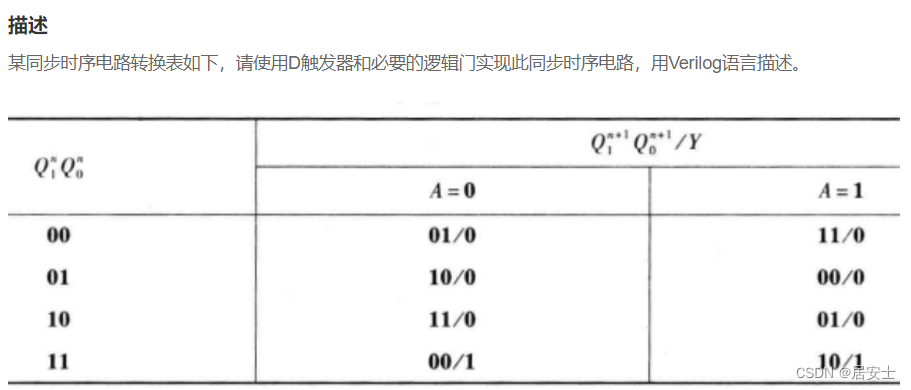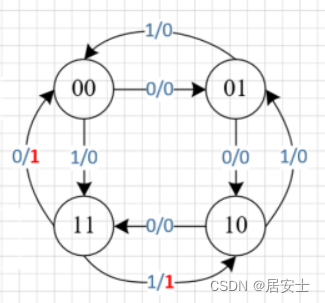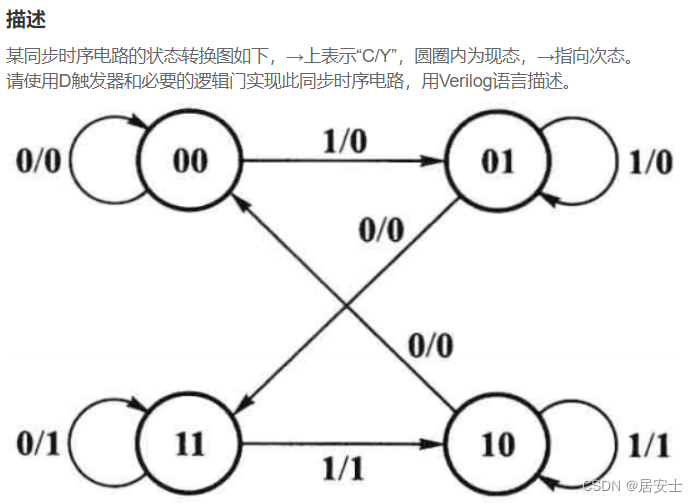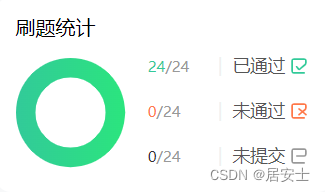牛客上组合逻辑部分的题也刷完了,详见主页的FPGA刷题P3和P4,接下来把最后一部分刷了

也就是时序逻辑部分:

目录
根据状态转移表实现时序电路

首先要看懂这个表,第一列是现态,A是跳转条件,A下面的 跳转的状态/输出的结果
接下来我们把状态转移表变成状态转移图:

根据状态转移图写代码:
module seq_circuit(
input A ,
input clk ,
input rst_n,
output wire Y
);
parameter s0=2'b00 ;
parameter s1=2'b01 ;
parameter s2=2'b10 ;
parameter s3=2'b11 ;
reg [1:0]cur_state ;
reg [1:0]next_state ;
reg Y0 ;
// one step
always@(posedge clk or negedge rst_n)begin
if(!rst_n)
cur_state<=s0 ;
else
cur_state<=next_state ;
end
// tow step
always@(*)begin
case(cur_state)
s0: next_state = A ? s3 : s1 ;
s1: next_state = A ? s0 : s2 ;
s2: next_state = A ? s1 : s3 ;
s3: next_state = A ? s2 : s0 ;
default: next_state = s0 ;
endcase
end
always @(*) begin
if(!rst_n)
Y0 <= 1'b0 ;
else begin
case(cur_state)
s0 : Y0 = 1'b0 ;
s1 : Y0 = 1'b0 ;
s2 : Y0 = 1'b0 ;
s3 : Y0 = 1'b1 ;
default : Y0 = 1'b0 ;
endcase
end
end
assign Y = Y0 ;
endmodule根据状态转移图实现时序电路

这一题直接给出了时序电路图,我们用Verilog语言描述:
module seq_circuit(
input C ,
input clk ,
input rst_n,
output wire Y
);
reg y;
reg [1:0] current_state,next_state;
always@(posedge clk or negedge rst_n )begin
if(~rst_n)begin
current_state<=2'b00;
end
else begin
current_state<=next_state;
end
end
always@(*)begin
case(current_state)
2'b00:next_state=C?2'b01:2'b00;
2'b01:next_state=C?2'b01:2'b11;
2'b10:next_state=C?2'b10:2'b00;
2'b11:next_state=C?2'b10:2'b11;
endcase
end
always@(*)begin
if(~rst_n)begin
y=1'b0;
end
else begin
case(current_state)
2'b00:y=1'd0;
2'b01:y=1'd0;
2'b10:begin
if(C==1'd0)begin
y=1'd0;
end
else begin
y=1'd1;
end
end
2'b11:y=1'd1;
endcase
end
end
assign Y=y;
endmoduleROM的简单实现

这个题要把地址和数据对应起来,ROM初始化的时候存入,后面只能读,深度为8恰好存满了
对于二维数组 定义方式:reg 【位宽】参数 【深度】;
module rom(
input clk,
input rst_n,
input [7:0]addr,
output [3:0]data
);
reg [3:0] rom[7:0];//前面是位宽,后面是深度
integer i;
always@(posedge clk or negedge rst_n )begin
if(~rst_n)begin//初始化
rom[0] <= 4'd0 ;
rom[1] <= 4'd2 ;
rom[2] <= 4'd4 ;
rom[3] <= 4'd6 ;
rom[4] <= 4'd8 ;
rom[5] <= 4'd10 ;
rom[6] <= 4'd12 ;
rom[7] <= 4'd14 ;
end
else begin
for(i=0;i<8;i=i+1)begin: rom_i //保持数据
rom[i]<=rom[i];
end
end
end
assign data=rom[addr];
endmodule边沿检测

这个题是叫我们产生上升沿和下降沿的信号
首先打一拍产生一个dly信号
上升沿:原始信号=1 && dly信号=0
下降沿:原始信号=0 && dly信号=1
module edge_detect(
input clk,
input rst_n,
input a,
output reg rise,
output reg down
);
reg a_dly;
always@(posedge clk or negedge rst_n)begin
if(~rst_n) begin
rise<=0;
down<=0;
end
else begin
a_dly <= a;
if ((~a_dly)&a)
rise <= 1;
else
rise <= 0;
if ((~a)&a_dly)
down <= 1;
else
down <= 0;
end
end
endmodule综上,牛客上Verilog部分的基础刷题都完成了!
